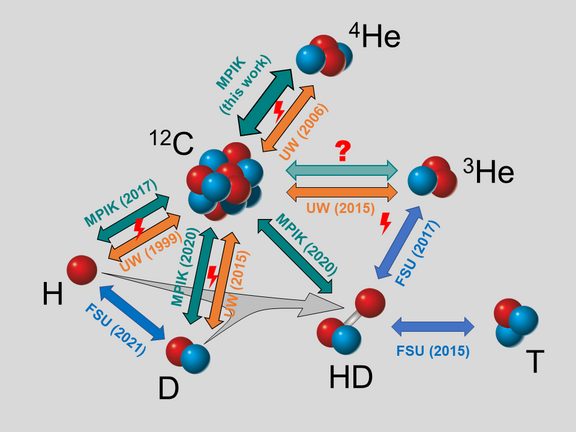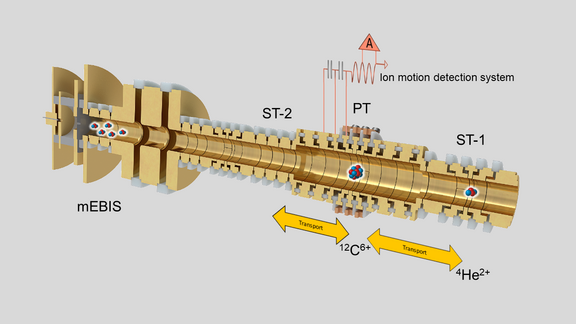Since many decades, precision measurements of fundamental systems provide a powerful method to test the validity of the Standard Model of physics and to explore its limitations. A prominent example was the discovery of the Lamb shift in 1947, a tiny energy difference in the measured spectrum of atomic hydrogen compared to the most precise theory then, which led to the development of quantum field theory. Today, fundamental properties of interest are the masses of the electron and, particularly, of light nuclei. Using specialized Penning traps, ion masses can be measured to parts-per-trillion (ppt) precision directly in atomic mass units u, defined as 1/12 of the atomic mass of the carbon isotope 12C.
Previous studies using the high-precision Penning trap for light ions (LIONTRAP) succeeded in measuring the masses of the proton and the deuteron with unprecedented precision. However, the results differ significantly from those by the University of Washington (UW), which either contributed to or served as previous literature values while, on the other hand, agree with mass ratios measured at the Florida State University (FSU). This inconsistency, called the “light ion mass puzzle”, is illustrated in Fig. 1. Moreover, the currently accepted literature value for the mass of the 4He nucleus (α particle) by the committee for science and technology (CODATA) as well as atomic mass evaluation (AME) relies solely on the results reported by the UW group.
He+ is the lightest hydrogen-like atomic ion, which makes it specifically interesting for fundamental physics. The behaviour of its single bound electron can be calculated to extraordinary precision, allowing for example to extract the electron’s atomic mass via a precision measurement of its magnetic properties (g-factor). However, given the discrepancies among 4He mass values from different groups, a consistent and precise remeasurement was urgently required. Therefore, physicists from the Max-Planck-Institute for Nuclear Physics (MPIK) in Heidelberg, the GSI Helmholtz Centre for Heavy Ion Research Darmstadt and the Heidelberg University measured the mass of the α particle directly relative to the carbon mass standard using the LIONTRAP apparatus.
The LIONTRAP mass spectrometer is located at the University of Mainz and was developed within a collaboration between MPIK and GSI. It consists of a threefold Penning trap (Fig. 2) located inside a superconducting magnet in nearly perfect vacuum at a temperature of about 4 degrees above absolute zero (–269°C). The trap is composed of the precision trap (PT) located between two storage traps (ST-1 and ST-2). Helium (4He2+) and carbon (12C6+) nuclei from a miniature electron beam ion source (mEBIS) are prepared in the apparatus and alternately transferred from one of the storage traps to the precision trap. The ions are confined radially by the magnetic field performing a cyclotron motion of which the frequency depends on the mass and the charge state of the ion and the magnetic field. Measuring the ratio of the frequencies of both ions directly provides the mass of the helium nucleus in atomic mass units referring to the carbon ion as the mass standard.
The physicists took great care of many unavoidable systematic effects – both minimising them and keeping them under control. As a result, and including the mass and binding energies of the two electrons, they obtained the atomic mass of the 4He as 4.002 603 254 653(48) u, with the number in parentheses indicating the overall uncertainty (standard deviation) of the last two digits which corresponds to a relative accuracy of 12 ppt. This is better than the UW result (16 ppt) but, however, deviates from their value by 522 pu or 6.6 combined standard deviations.
The next piece in the puzzle will be a remeasurement of the 3He mass using LIONTRAP which is currently under way.
Original publication:
Penning-Trap Mass Measurement of Helium-4
S. Sasidharan, O. Bezrodnova, S. Rau, W. Quint, S. Sturm and K. Blaum
Physical Review Letters131, 093201 (2023). DOI: 10.1103/PhysRevLett.131.093201
Weblinks:
Division ‘Stored and Cooled Ions’ (Prof. Klaus Blaum) at MPIK
LIONTRAP Experiment at the University of Mainz

